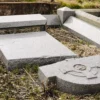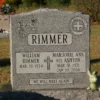A-Z of Memorial Terminology: A Helpful Guide to Memorial Terms and Meanings
“What is the difference between a tombstone and a headstone?” It’s a common question many families find themselves asking when planning a memorial.
The truth is, while these terms are often used interchangeably today, they originally had different meanings – and that’s just one example of how navigating memorial terminology can feel overwhelming.
At H&S Memorial Studio, we know this process can be both emotional and unfamiliar. For many people, navigating memorial planning is a first-time experience, and one of the most common things we hear is: “I don’t know what I am doing.”
It’s completely natural to feel uncertain – this isn’t something most of us prepare for. That’s why we’ve created this guide: to help you feel informed, supported, and confident as you make decisions.
Below you’ll find an A–Z list of commonly used terms, along with insights into frequently asked questions like how much a tombstone costs and how to clean a tombstone.
Whether you’re planning ahead or honoring someone’s memory, our team is here to guide you with care and expertise every step of the way.
For personalized guidance, feel free to contact us, we’re always ready to help.
A-Z of memorial terms you should know
A
- Appliqué – A decorative piece, often made from bronze or granite, attached to the surface of a monument.
- Approval Drawing – A detailed design proof provided to clients for review and approval before production begins. This ensures the layout, text, and design elements meet expectations.
- Ashes (Cremains) – The remains after cremation, which can be placed in urns, niches, or memorials.
B
- Base – The bottom section of a monument that supports the tablet or upright portion.
- Bevel Marker – A low-profile headstone with a slightly slanted face for easier readability.
- Bench (Memorial Bench) – A functional and decorative memorial often placed in cemeteries, parks, or gardens. Memorial benches can include inscriptions, plaques, or engravings and provide a peaceful space for reflection and remembrance.
- Bronze Plaque – A flat, decorative plate often attached to monuments or benches, commonly used for inscriptions or dedications.
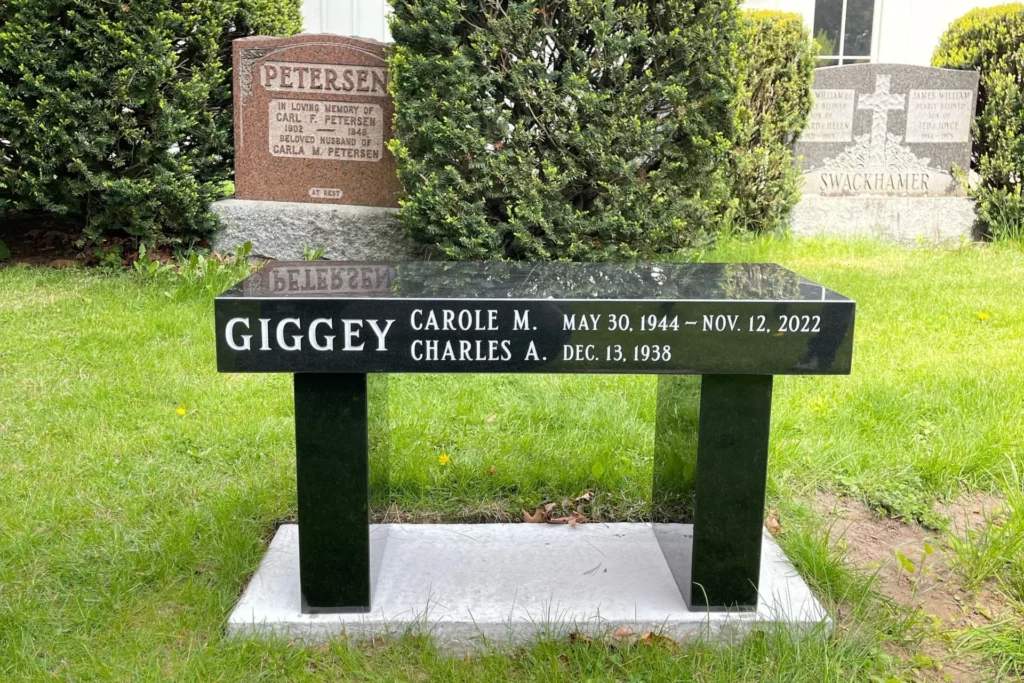
C
- Carving – The process of cutting into stone to create letters, symbols, or designs. Carving is typically done by hand or with specialized tools to add depth and texture to a memorial.
- Cemetery Markers – Flat monuments placed at gravesites to commemorate a loved one. Cemetery markers often include inscriptions, dates and decorative elements, providing a lasting tribute.
- Custom Memorials – Personalized monuments designed to reflect the unique personality, heritage, or preferences of the individual being honored. These can include custom carvings, shapes, and inscriptions.
- Computer-Aided Design (CAD) – A modern design process that uses software to create precise layouts and visual renderings of a memorial before production.
- Cremation Memorial – A monument or structure designed specifically to hold or commemorate cremated remains.
- Columbarium – A structure with niches designed to hold urns containing cremated remains.
D
- Design Consultation – A meeting between the client and memorial specialist to discuss design preferences, materials, and layout options.
- Die – The upright portion of a monument where inscriptions and artwork are placed.
- Double Monument – A memorial designed to commemorate two individuals, often used for couples.
E
- Epitaph – A short inscription or phrase honoring the deceased, often engraved on the monument.
- Engraving – The process of carving designs, lettering, or images into a monument.
- Etching – A technique used to create fine, detailed designs and lettering on a monument’s surface. Traditional etching is done with a diamond-tipped tool or sandblasting for precision.
- Ethnic Memorials – Custom-designed monuments that reflect cultural, religious, and traditional symbols to honor a family’s heritage. These memorials are personalized to celebrate diverse traditions and preserve meaningful legacies.
F
- Final Proof – The last version of the design sent to the client for approval before engraving or production begins.
- Flat Marker – A simple, flat headstone that lies flush with the ground.
- Foundation – The concrete base placed beneath a monument to ensure stability.
G
- Gravestone – Another term for a headstone or marker, used to commemorate a burial site.
- Granite – A durable and popular material used in creating memorials, valued for its longevity and beauty.
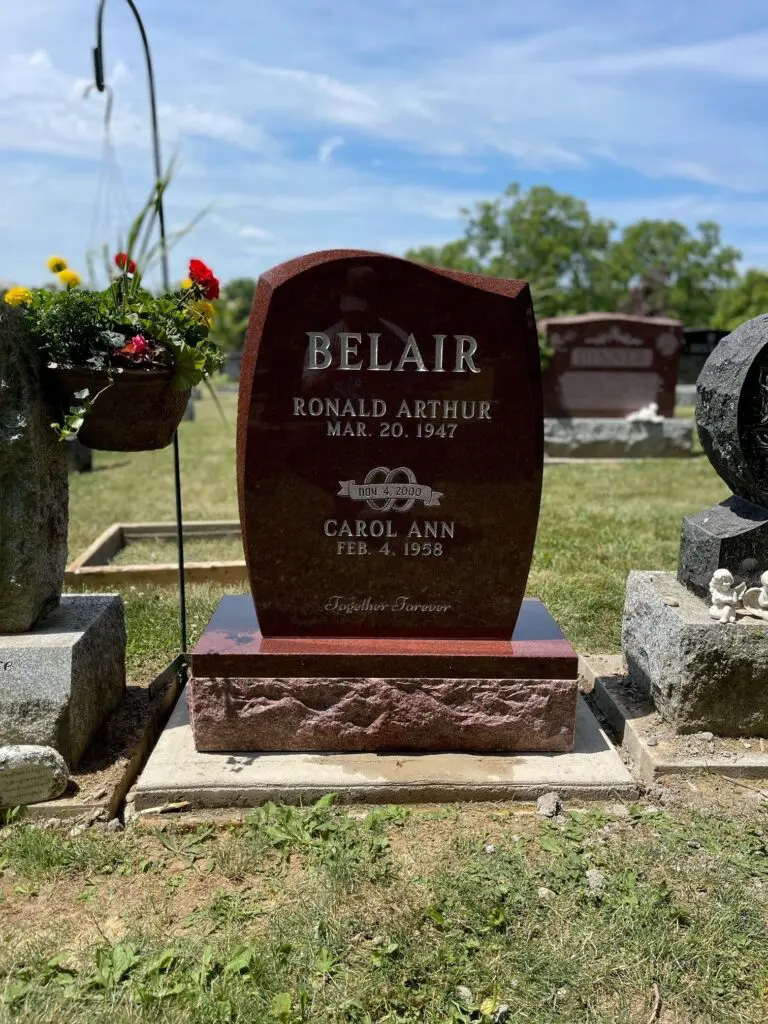
H
- Headstone – A stone or plaque placed at the head of a grave, typically engraved with the deceased’s name and details.
I
- Inscriptions – The text, such as names, dates, and epitaphs, engraved into a memorial.
- Interment – The act of placing a casket or urn into the ground or a niche.
- Installation – The process of placing the finished memorial at the gravesite or chosen location.
J & K
No relevant terms to note.
L
- Laser Etching – A precise method using laser technology to engrave detailed images, designs, or text onto the surface of a monument, allowing for intricate personalization.
- Layout – The arrangement of text, symbols, and designs on a memorial.
- Ledger Stone – A flat stone that covers the length of a grave.
- Lettering Styles – Various fonts or styles used for inscriptions on monuments.
M
- Memorial – A memorial is a broad term that refers to anything created to honor and remember a person, group, or event. It can take many forms, including headstones, plaques, benches, or even gardens and sculptures. Memorials are designed to serve as lasting tributes and places of reflection.
- Monument – A monument is a specific type of memorial that is typically a physical structure made of stone, granite, or marble. Monuments are often larger, upright designs such as headstones, obelisks, or statues, and they are commonly found in cemeteries or public spaces.
- Marker – A flat or upright memorial that marks a burial site.
- Mausoleum – A building or structure that houses one or more crypts for above-ground burials.
N
- Niche – A small compartment in a columbarium or mausoleum designed to hold an urn.
O
- Obelisk – A tall, slender monument with a pointed top, often used as a decorative feature.
- Ornamentation – Decorative elements added to enhance the design of a monument.
P
- Pedestal – A raised base that supports decorative urns or statues.
- Pet Markers – Memorials specifically designed to honor and remember beloved pets. These can include engraved names, dates, and personalized messages, offering a heartfelt tribute to a cherished companion.
- Plaque – A flat, engraved plate attached to a monument or structure.
- Polished Finish – A smooth, shiny surface applied to granite monuments, enhancing durability and appearance.
- Porcelain Photo – A ceramic image, often colored or black and white, added to a memorial to personalize it.
Q
- Quarry – a site where natural stone, such as granite, is carefully extracted. The unique textures and colours of the stone sourced from quarries allow us to offer a wide variety of memorial options.
R
- Restoration – The process of repairing and preserving existing monuments to maintain their original appearance and structural integrity, ensuring they continue to honor loved ones as intended.
- Rendering – A visual representation of the memorial design, showing what the final product will look like before production begins.
- Rush Order – An expedited production process for families needing a memorial completed quickly.
S
- Sandblasting – A method used to engrave designs and text into stone.
- Scroll – A carved design resembling a rolled-up parchment, often used for inscriptions.
- Sculpting – The process of shaping stone to create three-dimensional designs, figures, or statues. Sculpting often involves detailed handwork and is used to add artistic elements to monuments.
- Sealer – A protective coating applied to stone to help resist weathering and staining.
- Signage – Custom-designed stone signs created for businesses, parks, trails, and public spaces. Made from durable materials like granite and boulders, these signs are crafted with carving and laser etching techniques, offering long-lasting beauty and functionality.
- Slant Marker – A headstone with a slanted face, offering higher visibility than a flat marker.
T
- Tablet – The upright part of a headstone that typically holds the inscription.
- Tombstone – Originally, a tombstone referred to a stone slab that covered a grave, while a headstone marked the head of the grave. Today, the two terms are often used interchangeably to describe memorial markers. (Read more below).
- Tribute Design – A personalized engraving or etching reflecting hobbies, beliefs, or personality.
U
- Urn – A container used to hold cremated remains.
- Upright Monument – A traditional standing headstone, often paired with a base.
V
- Vase – An accessory added to a memorial to hold flowers.
- Vault – A protective, sealed container used to house a casket or urn underground.
- Veneer – A thin layer of stone or decorative material added to a monument’s surface to enhance its appearance.
W, X, Y & Z
No relevant terms to note.
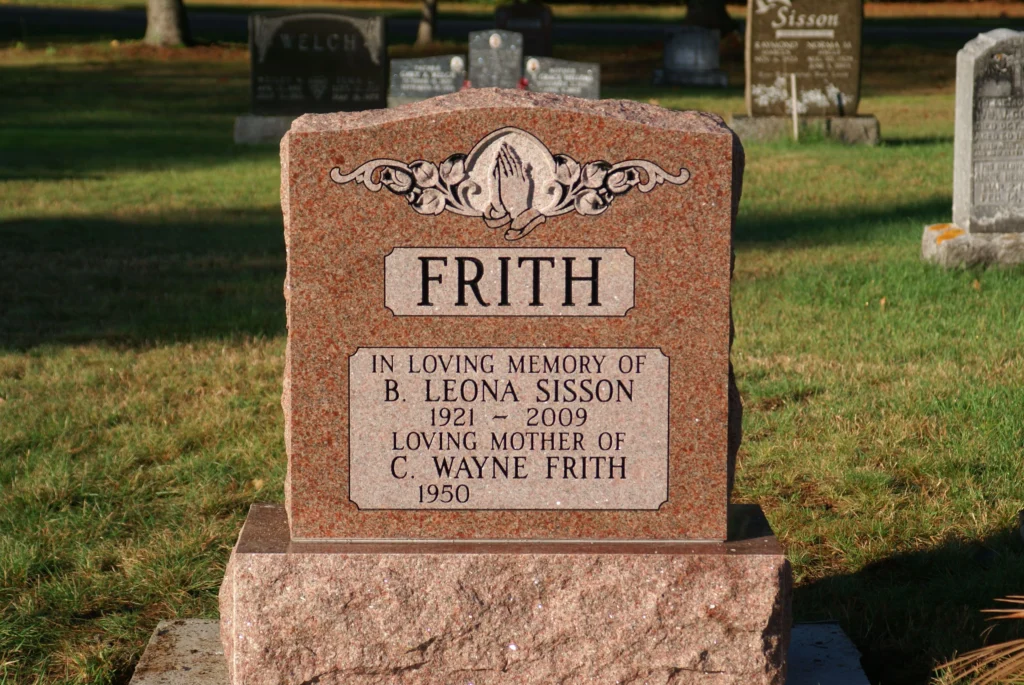
What’s the difference between a tombstone and a headstone?
Many people wonder whether there’s a difference between a tombstone and a headstone. Historically, the two terms had slightly different meanings:
- A tombstone originally referred to a stone slab laid flat over a grave.
- A headstone, as the name suggests, was a marker placed upright at the head of a grave.
Today, these terms are used interchangeably and both refer to memorials that mark burial sites, often engraved with names, dates, and meaningful inscriptions.
Whether you’re looking for a tombstone or headstone, the most important factor is creating a lasting tribute that reflects your loved one’s memory.
Guiding you through memorial planning
Designing and ordering a memorial can feel daunting, especially when faced with unfamiliar terminology. We hope this guide has made the process easier to understand and given you the confidence to make informed decisions during this important time.
From choosing the right materials and designs to creating a tribute that honors your loved one’s memory with care and precision, at H&S Memorial Studio, we’re here to guide you every step of the way.
If you have any questions about the terms we’ve covered or need personalized advice, don’t hesitate to reach out. With over 90 years of combined experience, we’re committed to making this process as thoughtful and stress-free as possible.
Contact us today to learn more about our services or to start creating a memorial that truly reflects your loved one’s legacy.
FAQs about tombstones and headstones
1. Are tombstones and headstones the same?
Yes, in modern usage, tombstones and headstones are often the same thing – memorial markers placed at gravesites. Historically, a tombstone referred to a flat slab covering a grave, while a headstone marked the head of a grave.
2. How much does a tombstone cost?
The cost of a tombstone depends on factors like material, size, design, and customizations. Simple flat markers are more affordable, while upright monuments with custom engravings or etchings tend to cost more. For personalized quotes, we recommend contacting us directly for a no-obligation consultation.
3. How do you clean tombstones?
Cleaning a tombstone requires care to avoid damage. Use a soft brush, mild dish soap, and water to gently remove dirt and moss. Learn more in our Monument Restoration blog, or, for tougher stains, consult a professional service to preserve the stone’s integrity.
4. What should I write on a tombstone?
Tombstones often include names, dates, and epitaphs, but they can also feature meaningful quotes, symbols, or personal messages. We offer expert guidance on creating inscriptions that honor your loved one’s life and legacy.

